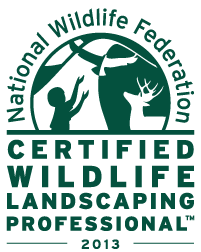Gardenscapes by Joanna LLC


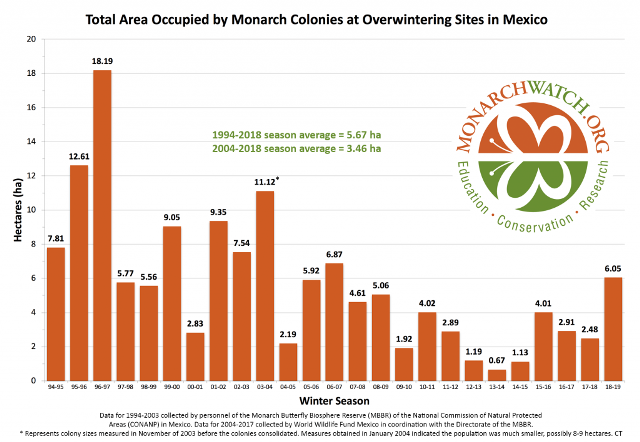
Call or E-mail us today!
Phone: (440) 935-5074
Please call for our landscaping services.
We design and install landscapes, patios and walkways.
Plant a Monarch Migration Station
and Help Save the Monarch Butterfly
Our company is a proud member of these organizations:
Ohio Native Perennials
Planting High Wildlife Value Plants
There are a lot more native perennials to Ohio than what is listed below, but these Ohio Natives represent high wildlife value plants. These are plants based mainly on the value of their fruits, seeds, and/or nectar used as food for wildlife/pollinators, and the relative number of species using the plant as food. Plant for the pollinators!
Most all the plants listed below are deer resistant. The key to using native plants successfully is carefully choosing plants that will match your site conditions.
High Wildlife Value Plants Native to Ohio
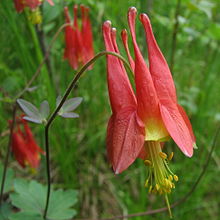
Aquilegia canadensis (Wild Columbine) above
Red flowers with yellow centers hang like drifts of softly illuminated lanterns in April and May. Excellent as a shady rock garden naturalizer, it also is quite content in average garden conditions. Occurs naturally in rich rocky woods, north-facing slopes, cliffs, ledges, pastures, and roadside banks.
12" - 24" H x 12" W; thrives in part to full shade in any well-drained soil. Plants tolerate full sun if temperatures are cool, but they prefer partial shade. They may go dormant in mid summer if stressed by heat or drought, but will emerge again in late winter. Plants reseed readily and plantings may double in size in two years.
Attracts hummingbirds, bees, butterflies and beneficial insects.
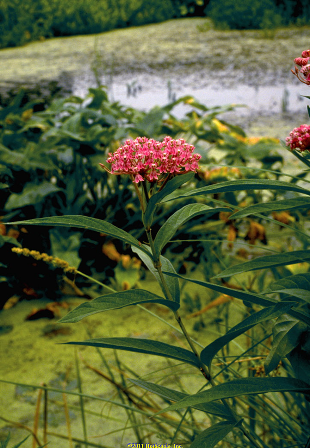
Asclepias incarnata (Swamp Milkweed) above
One of the most beautiful of native perennials with clusters of upturned pink flowers in June and July. Much underused in average garden conditions! 24" - 36" H, attracts butterflies of all kinds. Willow-like leaves are 4-5" long. Occurs in floodplains and wet meadows.
Swamp milkweed, true to its name, prefers consistently moist soil, but performs admirably in average, well-drained gardens as well. Full sun is best and some shade is tolerated, though blooming time and color may suffer.
Swamp Milkweed is very popular with pollinators! Hawk moths, Swallowtail butterflies, Greater Fritillaries, Monarch butterflies, skippers, bumble bees and numerous other nectar-seekers will visit this plant - even an occasional hummingbird. The leaves are a preferred food source for caterpillars of both the Monarch and Queen butterflies.
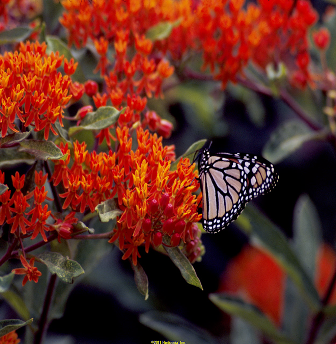
Asclepias tuberosa (Butterfly Weed) above
A tough, drought-tolerant native with intense orange flowers in mid to late summer. The Perennial Plant of the Year for 2017!
Attracts many varieties of butterflies and is a host plant to the Monarchs. A beautiful solution for a dry sunny slope! Occurs in dry fields and roadsides in most of the US
Butterfly weed prefers well-drained neutral to alkaline soils and full sun. It is one of many Asclepias species, all of which are required food for monarch butterfly larvae. It is also a great nectar plant for other butterflies and insects.
Butterfly weed is a 2' tall herbaceous perennial that dies back in winter and re-sprouts from its underground tuber each spring. The brilliant orange flower clusters appear in midsummer. These are followed by attractive green pods that open to release silky "parachutes" to drift away on autumn winds. Butterfly weed is unique among milkweeds in that the sap is not milky and the leaves are not opposite. Butterfly weed is a trouble-free perennial that will come up year after year in the same place without crowding its neighbors. Plant butterfly weed in mixed borders, meadows and natural areas. Butterfly weed is slow to emerge in spring, so you may want to mark where they are.
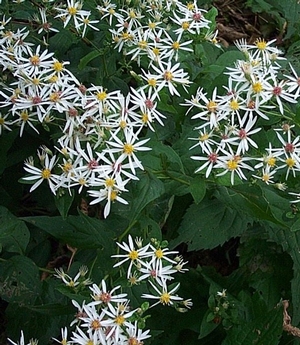
Aster divaricatus (White Wood Aster) above
The delicate, airy clouds of white wood aster are a must-have for every fall garden. This lovely aster is among the first to bloom in late summer. Small, white, daisy-like flowers with yellow centers that fade to red flower atop dark green to black stems. This perennial groundcover grows 1½-2½’ tall in filtered shade to full shade in neutral to slightly acidic soils. It is a good candidate for use on the woodland edge or in the naturalistic garden.
Produces a fairyland of glistening small white daisies in September and October. Lovely when naturalized in shade and average to dry soil.
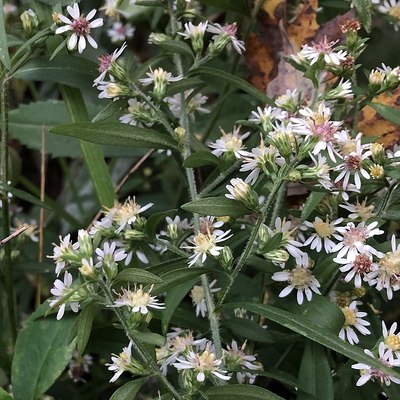
Aster lateriflorum (now known as Symphyotrichum - Calico Aster) above
Also known as white woodland, starved, or side-flowering aster, the calico aster is an Ohio herbaceous native plant with a bushy, clumping growth habit. It grows from one to three feet tall at maturity. Tiny blossoms measuring about one-third of an inch across cluster in upright panicle fashion along the upper side of each graceful stem.
They have delicate white rays and fuzzy-looking yellow centers that mature to shades of red and pink. As they don’t all mature at the same time, they have a multicolor “calico” appearance. Special value to native bees, butterflies, songbirds, and pollinators.
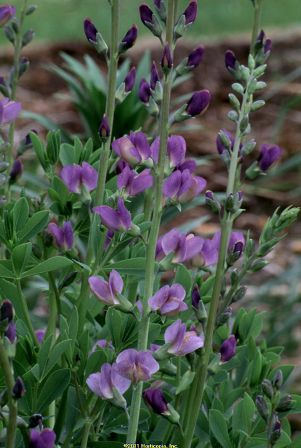
Baptisia australis (Blue False Indigo) above
Blue spikes of pea-shaped flowers resemble the tall racemes of lupines in May and early June. A slow to mature, but very rewarding native garden perennial.
Blue false indigo is a beautiful, long-lived, drought tolerant perennial with a robust habit and attractive foliage. In late May, its intensely saturated violet-blue flower spikes rise above 3-4’ tall multi-stemmed plants with bluish-green foliage. Baptisia australis prefers full sun to part shade in moist, well-drained to dry, and low nutrient soils. However, in too much shade or high nutrient soils, this plant flops over. Blue false indigo makes a stunning statement in the perennial border or naturalized in meadows.
Attracts butterflies and beneficial insects.
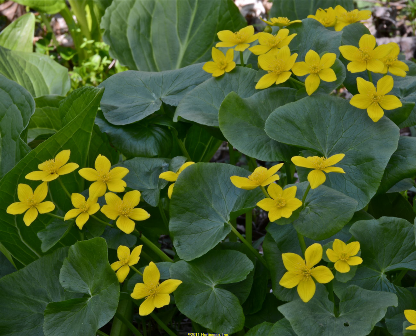
Caltha palustris (Marsh Marigold) above
This little beauty is at home at pond's edge or along a stream. It is clumping by nature, but can seed in to form a dense groundcover in a consistently moist site. In early spring, hundreds of bright yellow buttercup flowers dot the green carpet of cordate foliage. Deer usually leave this alone!
Its glossy green, kidney-shaped leaves grow to 12-18” and the entire plant can die to the ground by mid-summer. Caltha palustris performs best when planted in full sun to filtered shade in wet, humus-rich soils.
Attracts songbirds and other migratory birds.
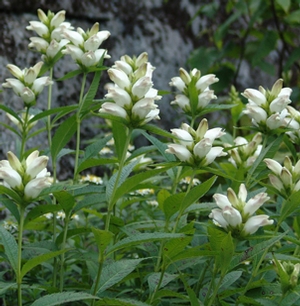
Chelone glabra (Turtlehead) above
The white or blush pink snapdragon-like flowers of Chelone glabra add a marvelous late summer charm to the garden when few other plants are blooming. Flowers bloom in upright, terminal spikes atop plants that ultimately reach 3-4’ tall. Turtlehead grows well in rich, moist soil that ranges from neutral to slightly acid and thrives in part shade to full sun as long as there is adequate moisture. Turtlehead makes an excellent accent specimen in the naturalistic garden or along streams. The foliage is deer resistant and is an important food and breeding source for butterflies.
Best grown in moist to wet, rich, humusy soils in part shade. Appreciates a good composted leaf mulch, particularly in sunny areas. Consider pinching back the stem ends in spring to reduce mature plant height, especially if growing plants in strongly shaded areas where they are more likely to need some support. In optimum environments, however, staking is usually not required.
Favorite breeding site for the Baltimore Checkerspot Butterfly and Hummingbirds.
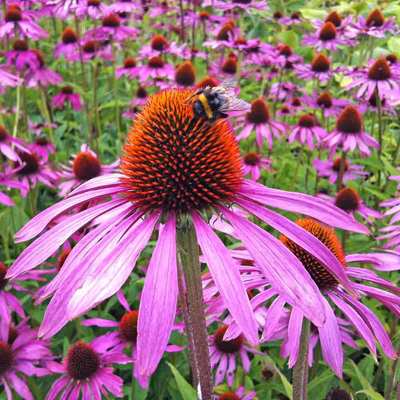
Echinacea purpurea (Purple Coneflower) above
Native bees, butterflies and skippers seek the nectar. Caterpillars of the Silvery Checkerspot Butterfly and several moths feed on the foliage and flowers. The Eastern Goldfinch relishes the nutlike seed. Echinacea purpurea prefers full to partial sun and medium soil conditions. Growth is best in fertile loam, but it will tolerate clay or dryer conditions. It is somewhat drought resistant, but the entire plant may wilt if the soil becomes too dry in strong sunlight. Echinacea species were used by Native Americans for medicinal purposes and are still used today in herbal medicine and tea. 3' to 4' H.
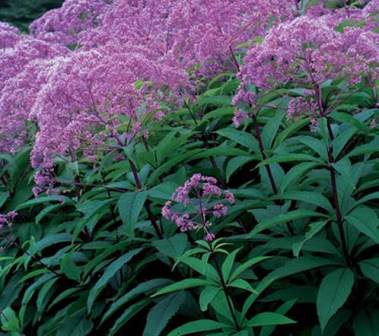
Eupatorium maculatum (Joe Pye Weed) above
All Joe Pye Weed plants are fabulous in their power to attract butterflies with its huge, bright mauve-pink flower clusters atop deep wine red stems. July to September bloom makes a bold and dramatic display when planted with Rudbeckia or tall ornamental grasses. Outrageous!
Eupatorium maculatum grows (to 4-5’ tall) and bushier with tighter and thicker inflorescences. It is an erect, clump-forming perennial that features coarsely-serrated, lance-shaped, dark green leaves, typically in whorls of 3-4 on sturdy, wine-red stems. Tiny, dusky rose-pink flowers in huge, terminal, domed, compound inflorescences (12-18” diameter) bloom in mid-summer to early fall. Flowers give way to attractive seed heads, which persist well into winter.
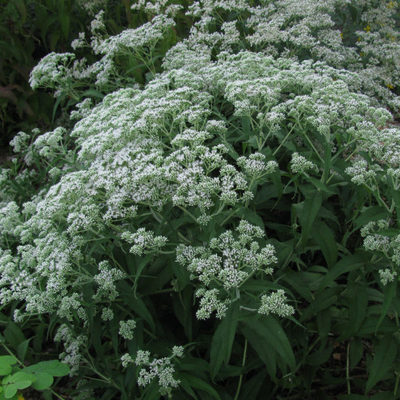
Eupatorium perfoliatum (Boneset) above
The fragrant white blooms attract butterflies and other pollinators. This species thrives in sun to part shade and in moist or wet soils. Plants are 3-5’ tall with a 2’ spread. Plants are pest resistant and foliage is unpalatable to deer and other herbivores. Eupatorium perfoliatum is a dramatic Accent for a Wildlife Garden or moist Meadow. Plants are also used as Butterfly Nectar Plants or as part of a Grouping or Mass Planting. This wildflower offers Showy Blooms and provides Erosion Control. It is useful in Stormwater Retention Basins and Rain Gardens. It can be used in Cottage Gardens, Deer Resistant Plantings, Water-wise Landscapes, Low Maintenance Plantings, Perennial Borders or Shade Gardens.
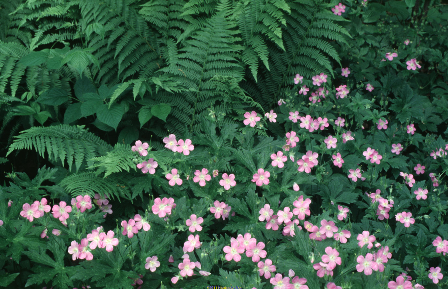
Geranium maculatum (Wild Geranium) above
Wild geranium is a beautiful, easily grown perennial wildflower for use in the naturalistic woodland garden. The 1¼” wide pink to magenta flowers are delicately colored and veined. They rise on a sturdy stem above attractively textured palmate leaves. This reliable, clump-forming perennial grows from 12-24” tall and 18” wide. It is easily established in moist, well-drained soils and spreads moderately by seed. To perform best wild geranium prefers partial shade to shade.
Attracts beneficial insects, songbirds, migratory birds and butterflies.
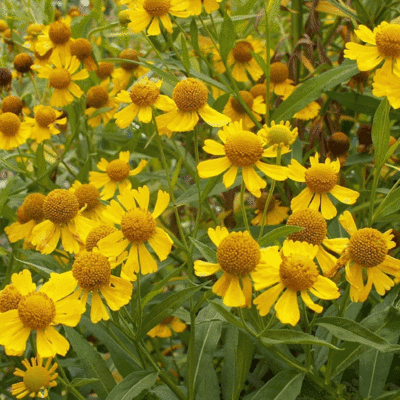
Helenium autumnale (Sneezeweed) above
Helenium autumnale is an upright clumping perennial wildflower. Plants have unique winged stems clothed in elongated bright green leaves. In autumn foliage is crowned by an abundance of golden daisy-like flower heads. The blooms are visited by throngs of pollinators. This adaptable plant will grow in any site that has sun or part sun and wet to moist soils. Flowering begins in late summer or early fall and continues for 1-2 months. Rusty brownish seed clusters follow. Plants grow 3-5’ tall with 3’ spread.
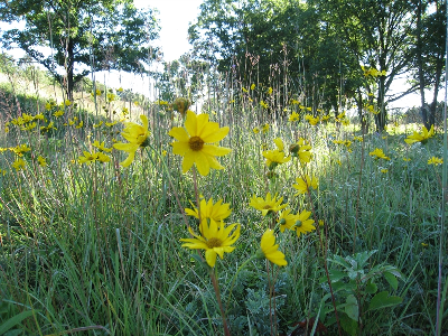
Helianthus occidentalis (Ox-Eye Sunflower) above
Ox -Eye Sunflower is one of the shortest of the many sunflowers that are native to the United States. Large, long-stalked leaves (to 8” long) form a 4-8” tall foliage clump. Sunflowers (to 2” diameter) with orange-yellow rays and yellow disks appear on stiff, almost naked, flower stems that typically rise to a height of 2-3’ (less frequently to 4’) tall. Blooms from mid-summer to fall. This plant is also sometimes commonly called naked stemmed sunflower and fewleaf sunflower in reference to the almost total absence of leaves from the flowering stems.
Best grown in average, dry to medium, well-drained soils in full sun. Tolerates a wide range of soils. Tolerates dry soils and drought.
Attracts butterflies, songbirds and other migratory birds.
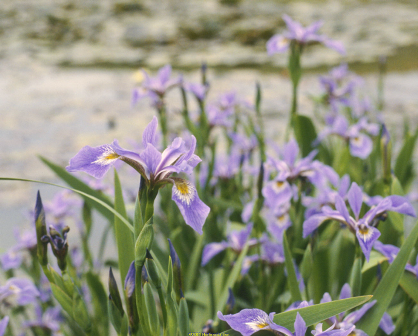
Iris versicolor (Blue Flag) above
Moist and wet areas provide the perfect setting for blue flag in the garden. In late spring to early summer, Iris versicolor produces stems containing several striking blue 3-4” flowers with a prominent yellow blotch on 2-3’ tall plants. Its sword-like, upright foliage is an attractive accent to the summer garden. In addition to wet conditions, blue flag grows well in average soil and filtered shade to sun. Blue flag makes an excellent focal point in a small pond or can be used in an area that is too wet for other garden plants.
Attracts bees, butterflies, hummingbirds and birds.
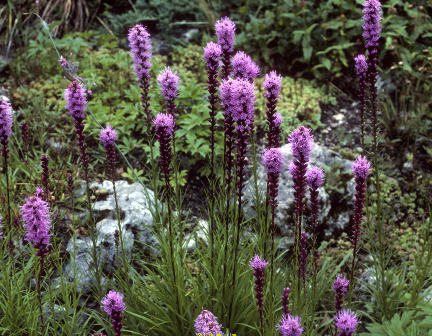
Liatris spicata (Blazing Star) above
Upright spikes bearing pinkish-purple tassels in July and August. One of the best garden performers! An excellent cut flower and a magnet for butterflies, bees, rare moths and hummingbirds. Deer resistant!
Because of their vertical nature, Liatris species take up minimal space and are suitable for even the smallest garden. They are equally at home in large, established perennial borders, where their thin, tall, airy floral wands create a mesmerizing "pop-up" effect.
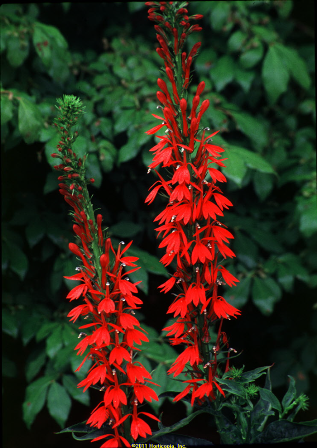
Lobelia cardinalis (Cardinal Flower) above
Cardinal flower is a sure bet for gardeners anxious to have hummingbirds, beneficial insects, butterflies, and birds visit their gardens. Set against deep green foliage, pure red flowers appear on 2’ long spikes atop 3-4’ tall plants providing a spectacular garden display in the heat of summer. Cardinal flower flourishes in acidic to neutral, well drained soils in filtered shade to sun. Stream banks, water’s edge, meadow margins, and garden soils less prone to drought stress are excellent sites to grow this herbaceous perennial.
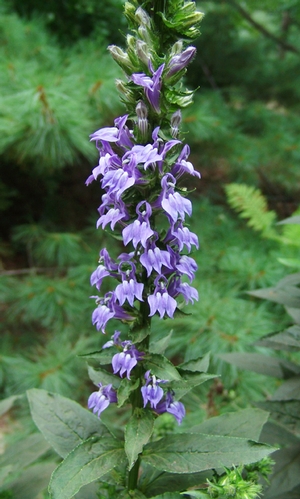
Lobelia siphilitica (Great Blue Lobelia) above
This native perennial heralds the end of summer. Its showy, blue flowers on a 1-3’ tall stems, are a must for the naturalized garden. Great blue lobelia flourishes in moist soil with filtered shade but will adapt to drier conditions with more shade. This herbaceous plant is easy to grow from seed and frequently self-sows. Lobelia siphilitica is tolerant of acid to neutral conditions.
Attract butterflies, hummingbirds and neighbors to your garden!
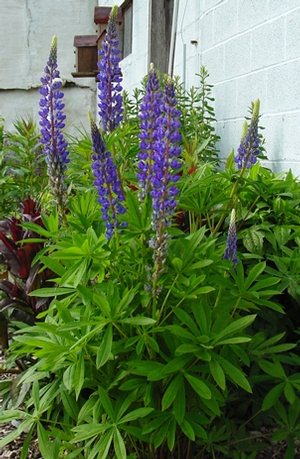
Lupinis perennis (Wild Lupine) above
Fragrant, pea-like, blue to violet flowers in late spring with leaves that are palmately divided into 7-11 leaflets. Enhances soil fertility by fixing atmospheric nitrogen into a useful form. Requires good drainage. 1' to 2' H.
The sole host plant for the Karner blue butterfly. Also a host plant for the Frosted Elfin butterfly. Attracts other beneficial pollinators and hummingbirds as well. Birds and small mammals enjoy the seeds.
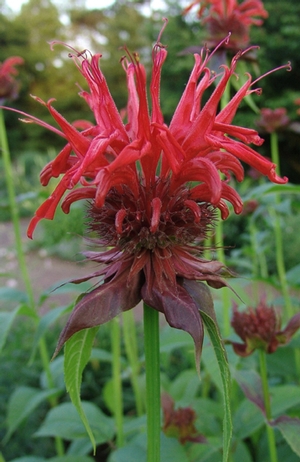
Monarda didyma (Beebalm) above
Wonderfully aromatic foliage and stems with enormous red tubular flowers from June to August. Cherished by butterflies and hummingbirds and beneficial insects.
Grow in full sun and average to moist soil with good drainage. Water well on planting and regularly until established. Drought tolerant and mildew resistant.
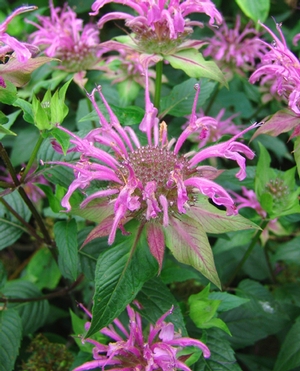
Monarda fistulosa (Wild Bergamont) above
Lovely lavender flowers top aromatic foliage. Easy to grow in a perennial border, wildflower garden or meadow. Wild bergamot is a great naturalizing wildflower that gets 3 to 5 ft. tall.
The nectar of the flowers attracts long-tongued bees, bee flies, butterflies, skippers, and hummingbird moths. Among the long-tongued bees, are such visitors as bumblebees, Miner bees, Epeoline Cuckoo bees, and large Leaf-Cutting bees. A small black bee (Dufourea monardae) specializes in the pollination of Monarda flowers. Sometimes Halictid bees collect pollen, while some wasps steal nectar by perforating the nectar tube. The Ruby-Throated Hummingbird also visits the flowers
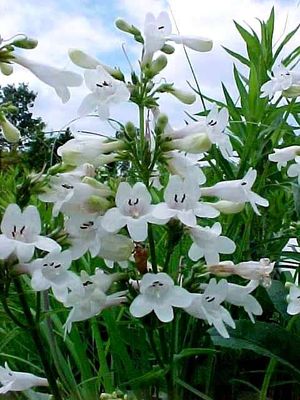
Penstemon digitalis (Smooth Penstemon) above
In early summer, white or light-pink-tinted, tubular 1" flowers on branching, hollow stalks rise above a basal rosette of lustrous dark green leaves. Drought tolerant, tough as nails, and deer resistant. The tubular flowers make an excellent landing pad for bees, butterflies and hummingbirds alike!
Prefers average to moist, well-drained soil in full to partial sun. Penstemon digitalis is drought tolerant but grows poorly in heavy clay soils. Great for wild and perennial gardens, xeriscaping as well as naturalized areas. Grows 3 to 4 ft. H.
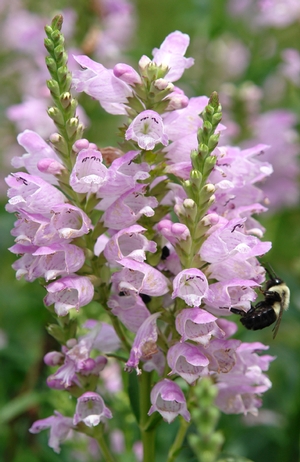
Physostegia virginiana (Obedient Plant) above
Tubular flowers in shades of lavender-pink adorn this taller plant from midsummer through autumn. As expected, it holds an upright, clump forming habit with attractive medium green foliage and grows to about 36” tall and 20” wide. An adaptable and easy-to-grow native, the strong stems do not require staking.
Blooms June to September. A nice late season addition to the garden for bees and hummingbirds.
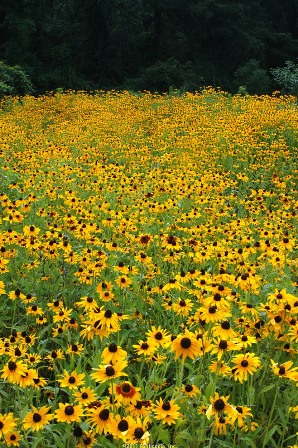
Rudbeckia hirta (Black eyed Susan) above
This Ohio native wildflower typically occurs in open woods, prairies, fields, and roadsides throughout the State. It is a coarse, hairy, plant that features daisy-like flowers (to 3” across) with bright yellow to orange-yellow rays and domed, dark chocolate-brown center disks. Blooms throughout the summer atop stiff, leafy, upright stems growing 1-3’ tall. It has rough, hairy, leaves (3-7” long).
Tolerates heat, drought and a wide range of soils except poorly-drained wet ones.
Attracts birds, butterflies, bees and beneficial insects.
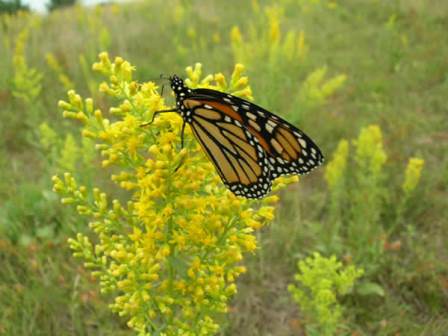
Solidago speciosa (Showy Goldenrod) above
Showy goldenrod is a rhizomatous, native perennial which typically occurs in dry soils in open woods, fields and prairies throughout most of the State. Features tiny, bright yellow flowers that bloom in dense, erect, club-shaped terminal clusters atop stiff, narrow-leaved, reddish stems typically growing 2-3' tall. Flowers bloom mid to late summer. As the common name suggests, this species is one of the showiest of the many goldenrods. Goldenrods have been wrongly accused of causing hay fever which is actually an allergic reaction to wind-borne pollen from other plants such as ragweed.
Attractive to bees, butterflies and birds.
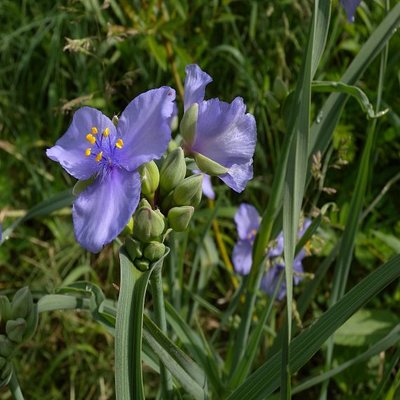
Tradescantia ohiensis (Spiderwort) above
This spiderwort of Ohio is a great landscape plant for hot sunny locations, unlike other plants in the genus. The attractive bluish-grey foliage sport flowers in blue, pink or purple from early June to September, giving Tradescantia ohiensis a long season of bloom time. It grows 24-36” tall and 18-30” wide. Spiderwort has similar foliage to daylily and is easiest to think of as a flowering grass-like, drought-loving native perennial.
It grows well in a variety of soils and moisture requirements but prefers moist to dry, well-drained sandy acidic soils in full to partial sun. That being said, spiderwort is commonly found in disturbed areas such as along railroad tracks, and in moist meadows, prairies, and thickets. In areas where the plant is happily situated, it can become quite aggressive and self-sow readily. The plant can be divided when it becomes overcrowded and will grow quite well in part-shade, specifically beneath large deciduous trees, but will offer less bloom. Great plant for pollinators.
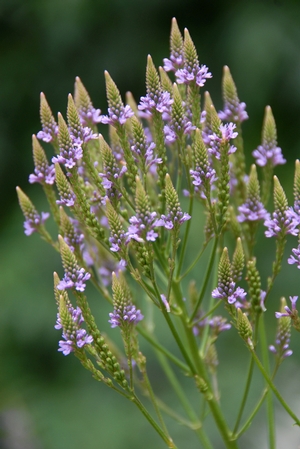
Verbena hastata (Blue Vervain) above
The tall thin spikes of Blue Vervain grace the wet meadows of our state in July and August. A great plant for pond's edge where it seeds in between sedges and rushes and cheerfully holds its own. Verbena hastata prefers moist to average, well-drained, moderately acid soils in full sun. Reaches heights of 4-6 ft. Can tolerate drier soils, but prefers to stay moist.
Attracts butterflies, birds, waterfowl, and beneficial insects.
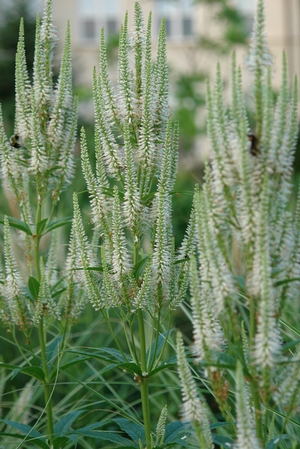
Veronicastrum virginicum (Culiver's Root) above
With its candelabra-like display of white flowers, Culver’s root makes an elegant vertical statement in the mixed border or meadow planting. Occurring in early to mid-summer, white to pale lavender flowers bloom in dense arrangements on branched terminal spikes. Dark green leaves add visual interest with their whorled arrangement along the erect 3½-5’ stems. Plants flourish in full sun in an average to rich garden soil that is moist to wet and well drained.
Attracts butterflies and beneficial insects.
Thank you for visiting our website.

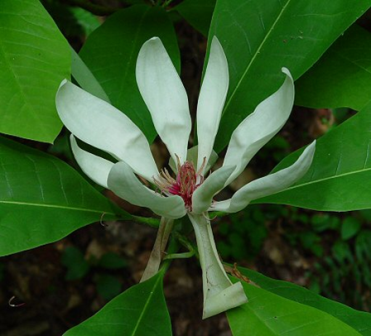
Copyright © 2010

